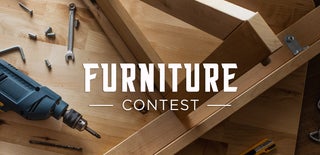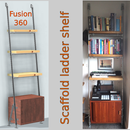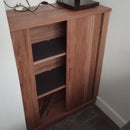Introduction: Mid Century Side Table
I had seen some lovely side tables in the internet with a mid-century style and also some great artistic ways to use wood to create textures. I wanted to create a single drawer side table with a textured front drawer panel so experimented with a couple of techniques to create the final effect I came up with. The textured panel comprise 16 rectangular pieces which have been individualy turned on a lathe and glued together on a backing board.
The main striped body is made from sapele and ash hardwood, the draw front is also sapele and the legs are also ash. The main draw element is made from larch and the bottom from hardboard covered with recycled leather.
Supplies
Materials
The cutting list and final dimensions are given in the included diagrams - one set is in mm and the other in inches, so hopefully should help more people.
In general I used sapele and ash hardwood, larch, hardwood and thin ply.
Harwax oil for finishing
Tools
These are the ones I used but I'm sure the table can made with less or more tools.
Thickness planner / planner jointer
Table saw
Band saw
Wood turning lathe
Random orbital sander
Belt sander
Biscuit jointer
Drills
Many clamps
Step 1: Top and Sides Prep
The sapele I used were from offcuts of 100x150x700mm (4"x6"x27.5") beams that were left over from some building work I had done, so I cut the beams in to planks on the band saw and thicknessed them along with the ash used for the stripe. I then squared up all the sides.
I next glued the parts together to make two stripey boards and clamped together for a few hours.
Once dry I put the boards on a planner router sled and made the boards completely flat and a constant thickness.
I then cut the boards with a mitre of 45 deg so I could eventually construct a mitred open end box.
Step 2: Prep the Main Body
To ensure the mitred joints were strong enough I opted for a simple biscuit joint, this would make the joints simple to make and give a really good strong joint.
Before gluing I added a large chamfer to the front of the main body and routed a groove to the back of the main body ready to take a piece of hardboard. I then sanded what will be the internal faces of the main body.
Step 3: Drawers
I had some larch that had been hanging qround for a couple of years so decided to use that for the drawer. Once cut to size and thicknessed I determined the dimensions from the as yet unglued main body, taking in to account the size of the gap required for the drawer runners. I then routed a groove around the bottom of the drawers for the hardboard bottom and a groove along the outside edges for the drawer runners.
Once the bottom was cut I put the drawer together fixing with screws.
Step 4: Drawer Runners and Gluing Up
At this point I had an unglued main body and finished drawer body. I positioned the drawer body in to the 'box' and determined the best position for the drawer runners and marked these on the inside of the main body when it was fitted together. Now marked, I took the body apart so I could install the drawer runners. I also added an extra rail along the top of the drawer and added a stop block to the rear of the drawer. This would stop accidental complete pull out of the drawer.
Now all the bits were done I glued the body together, with a rear hardboard panel, and clamped together with a band clamp and many other clamps.
Step 5: Drawer Front and Gluing Up
The final part of the drawer was now the texured wood front. This is made up from 16 wood turned rectangles glued together on top thin plywood to make a single piece. I did try a couple of different methods to make the individual parts and found this lathe method was by far the easiest and quickest.
After cutting each of the individual pieces I attached a backing board to the face plate of the lathe. This would enable me to screw the back of the pieces to the face plate.
I started off with the first one and added a curve to the front of the block until it looked 'about right'. Once shaped, I sanded up to 400 grit then waxed and polished until it was nice a shiney! Now I had the first piece finished I used the curve on that one to mark on to the subsequent ones so they would all be uniform.
It does take a while as there are 16 of them so at a minimum of 10 minutes each that is at least 2hr 40min.
Once they were all done I cut a piece of plywood slightly oversize and glued the blocks on to the plywood and to the edges of the others.
Step 6: Drawer Front Knob
I hadn't thought about using the drawer up to this point so decided to turn a knob that I could fit on to the front of the drawer.
I decided to turn a knob with a concave face which would contrast with the convex faces of the remainder of the draw face. Once I was happy with the shape I turned the back of it to an exact dimenison of a spade drill bit.
Next came the worse part - drilling in to the complete drawer front! I decided to use a spade bit as there is a nice long point which would start the hole directely in the centre of the drawer front. Luckily with the help of my drill press and a clamp or two I managed to drill a hole with nothing going wrong.
I then glued the knob and inserted it in to the hole. No clamps were needed though as the joint was tight enough.
I then screwed the drawer front to the drawer body making sure it was as central as possible.
Step 7: Legs
The last major job was the legs. I had a little bit of ash in the workshop which was just large enough to make four slender legs that I cut on the band saw.
I then made a curved peice of ash that I could then screw the legs to and bolt in to the main body. I didn't need these bit too thick so I cut it in two on the band saw giving me nice matching parts.
Having then cut a angle on to the top and bottom of the legs I attached the legs to the curved parts with screws. I made the angles to around 10 deg as this made the bottom of the legs in line with the top of the main body.
I drilled some holes in to the underside of the main body and screwed in some insert nuts (countersinking a little so the legs fit flat to the face). Once the matching holes were cut into the curved bit I could attached then with joint connector bolts which fitted on to a reccessed hole.
Step 8: Finishing and Finished
Now everthing was ready I sanded all of the parts to 320 grit and finished with a couple of layers of hardwax oil.
I then put it all together and was very pleased with the outcome and maybe the nicest bit of furniture I've made so far.
I hope you enjoyed my instuctable and if you did please think about voting for me in the furniture contest (I would love a nice new instructables t-shirt)
Cheers!

Runner Up in the
Furniture Contest













